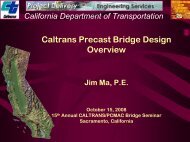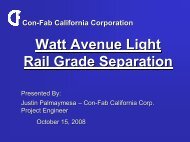Caltrans Precast Concrete Committee Caltrans Precast Concrete
Caltrans Precast Concrete Committee Caltrans Precast Concrete
Caltrans Precast Concrete Committee Caltrans Precast Concrete
Create successful ePaper yourself
Turn your PDF publications into a flip-book with our unique Google optimized e-Paper software.
California Department of Transportation<br />
<strong>Caltrans</strong> <strong>Precast</strong> <strong>Concrete</strong> <strong>Committee</strong><br />
Update<br />
Jim Ma, P.E.<br />
Prestressed <strong>Concrete</strong> Specialist Specialist, <strong>Caltrans</strong><br />
Nov. 3 rd , 2010<br />
2010 <strong>Caltrans</strong>/PCMAC/Consultants Bridge Workshop
California Department of Transportation<br />
Current <strong>Committee</strong> Members<br />
Fit Fritz Hoffman, H ff SD<br />
Douglas Dunrud, SD<br />
Phil Lutz, SD<br />
Manode Kodsuntie, SD<br />
Eric Fredrickson, OSFP<br />
Say-Gunn Low, OSFP<br />
Jeremy S Wright, OSFP<br />
Keith Hoffman, METS<br />
Tom Ruckman, Specifications<br />
Cheryl Poulin, Construction<br />
Jim Ma, ESPD (Engineering Services Policy Development)<br />
Sue Hida, ESPD (Engineering ( g g Services Policy y Development) p )
PC <strong>Committee</strong> Mission and Goal<br />
Mission<br />
TTo Provide P id PRECAST (P (Policy, li RResource, EExpertise, ti<br />
Coordination, Assistance, Standards, Training)<br />
Goal<br />
PProvide id TTechnical h i lS Support tt to Design D i and d<br />
Construction for <strong>Precast</strong> Bridge Structures in CA<br />
Promote ABC by Using <strong>Precast</strong> Products<br />
Promote Prefabricated Bridge Elements and<br />
Systems y (PBES) ( ) to Support pp<br />
FHWA “EDC” Initiative
Typical Cast-in-Place Falsework
California <strong>Precast</strong> Bridge Design Challenges<br />
Current Bridge Data: CIP 70% +, <strong>Precast</strong> 25% -<br />
<strong>Precast</strong> Advantages:<br />
WHY ???<br />
RRapid idconstruction i<br />
Minimize falsework<br />
Reduce traffic disruptions p on-site<br />
Improve safety for traffic and<br />
construction workers<br />
Minimize environmental impact<br />
Increase product quality<br />
<strong>Precast</strong> Challenges:<br />
Si Seismic i Design i<br />
Construction Cost<br />
Longer Span
<strong>Precast</strong> Bridge Seismic Design<br />
CONNECTION CONNECTION, CONNECTION CONNECTION, CONNECTION
California <strong>Precast</strong> Girder Bridge<br />
with ihDiff Different Connections C i<br />
Typical California <strong>Precast</strong> Girder/Bent Cap Connections:<br />
Drop Bent Cap Connection<br />
Inverted-T Bent Cap Connection<br />
Integral g Drop p Bent Cap p Connection<br />
Integral Bent Cap Connection
<strong>Precast</strong> Girder Connection Design and Details<br />
Drop p Bent Cap p Connection<br />
Continuous superstructure<br />
Pinned between superstructure<br />
and cap<br />
Column/footing connection has to<br />
be fixed<br />
EExtend t d PC girder i d bbottom tt strands t d<br />
Good seismic connection
<strong>Precast</strong> Girder Connection Design and Details<br />
Inverted-T Bent Cap p Connection<br />
Semi-continuous superstructure<br />
Considered as pinned between<br />
superstructure and cap<br />
Column/footing connection has to be<br />
fixed<br />
SSeismic i i research h study t d on-going<br />
i
<strong>Precast</strong> Girder Connection Design and Details<br />
Integral Drop Bent Cap Connection<br />
Continuous superstructure<br />
Fixed between superstructure p<br />
and<br />
cap<br />
Column/footing connection could<br />
be pinned<br />
Good seismic connection
<strong>Precast</strong> Girder Connection Design and Details<br />
Integral Bent Cap Connection<br />
Integral Bent Cap Connection<br />
Continuous superstructure<br />
Fixed between<br />
superstructure and cap<br />
Column/footing connection<br />
could be pinned<br />
Great seismic connection
Current <strong>Precast</strong> Bridge Cost
Current California Bridge Cost
Current PC <strong>Committee</strong> Working Items<br />
LRFD <strong>Precast</strong> Guidance Materials for Designers:<br />
11. Bridge Design Aids Chapter 6 (New Wide Wide-Flange Flange Girder, Girder Box<br />
Section, Trapezoidal Section, Voided Slab Table)<br />
2. Bridge Memo to Designers: 11-8 “Design of <strong>Precast</strong> Prestressed<br />
Girders”<br />
3. Bridge Design Practice Manual: Chapter 10 “PC/PS <strong>Concrete</strong> Girder<br />
Design g Example” p<br />
4. <strong>Caltrans</strong> Standard Drawings:<br />
<strong>Precast</strong> Prestressed I-Girder<br />
<strong>Precast</strong> Prestressed Bulb Bulb-Tee Tee Girder (Harped Strands 2 sheets, sheets<br />
Debonded Strands 2 sheets)<br />
<strong>Precast</strong> Prestressed Voided Slab<br />
<strong>Precast</strong> Prestressed d Wide-Flanged id l dGi Girder d (under-development)<br />
( d d l )<br />
<strong>Precast</strong> Deck Panel (under-development)
California Department of Transportation<br />
California <strong>Precast</strong> Girder Inventory and Span Capacity
California <strong>Precast</strong>-Pretensioned Girders<br />
<strong>Precast</strong> Girder Shapes<br />
Common Used Shapes<br />
California I-Girders I Girders<br />
California Bulb-Tee<br />
California Bath-Tub<br />
California Voided Slabs<br />
<strong>Precast</strong> Box Beams<br />
P<strong>Precast</strong> tDDelta lt Girders Gi d<br />
CA WF Girder
California <strong>Precast</strong>-Pretensioned Girders<br />
Common Shapes and Span Length Summary
California Department of Transportation<br />
CCalifornia lif i Wide-Flange Wid Fl Gi Girder<br />
d
California <strong>Precast</strong> Girder Bridge g Span p Capacity p y<br />
Typical <strong>Precast</strong> Girder: 30’-180’<br />
Post-Tensioned Spliced <strong>Precast</strong> Girder: 100’-300’<br />
Segmental g<br />
<strong>Precast</strong> Girder: 200’-450’
Two Methods for Post-Tensioned Spliced <strong>Precast</strong> Girders<br />
Method 1: Splicing Girders Supported on Limited Falsework
Two Methods for Post-Tensioned Spliced <strong>Precast</strong> Girders<br />
Method 2: Splicing Girders on the Ground (Without Falsework)
PT Spliced <strong>Precast</strong> Girder Advantages<br />
Very limited falsework or no falsework<br />
Longer spans<br />
Maximize vertical clearance<br />
Rapid p construction<br />
Continuous superstructure with no joints<br />
Integral system between superstructure, bent<br />
cap and columns<br />
Seismic resistance connection<br />
Could be pinned at column bottom<br />
Smaller footing size<br />
Aesthetic pleasant<br />
Low construction cost




